Andrew Cartmel's Blog, page 3
September 20, 2020
Savages by Winslow, Salerno & Stone
 I am continuing my survey of the films of Oliver Stone, but this week I'm veering away from his Vietnam trilogy (Platoon, Born on the Fourth of July, Heaven and Earth) to discuss Savages, a more recent thriller.
I am continuing my survey of the films of Oliver Stone, but this week I'm veering away from his Vietnam trilogy (Platoon, Born on the Fourth of July, Heaven and Earth) to discuss Savages, a more recent thriller.Released in 2012, it's based on a novel by Don Winslow, who is a master of the thriller form. I discussed Winslow's novel, which is excellent, here, where I describe Stone's film of the book as "flawed but impressive."
Well, on a second viewing, I'm more impressed than ever but the flaw hasn't vanished...
Savages was adapted to the screen by Winslow himself with Olive r Stone, and Shane Salerno. (Salerno and Don Winslow had previously co-created the TV series UC: Undercover.)
r Stone, and Shane Salerno. (Salerno and Don Winslow had previously co-created the TV series UC: Undercover.)
It is the story of two young California cannabis entrepreneurs — pre-legalisation.
Ben (Aaron Taylor-Johnson) is a genius hippie botanist. His good buddy Chon (Taylor Kitsch) is a former special forces vet.
(Oliver Stone makes the interesting point that their characters correspond to Elias and Barnes in Platoon.)
Ben and Chon are involved in a triangular relationship with Ophelia, known as 'O' (Blake Lively).
The story begins when a Mexican drugs cartel moves in to buy a controlling stake in their dope growing operation.
When Ben and Chon refuse to sell, the cartel kidnaps Ophelia to apply pressure to them.
From that point on you can pretty much imagine what happens...
Following th e example of Simon Moore's Traffik, the cartel is run by a woman, the slinky Elena (Salma Hayek), because her husband is indisposed. (In this case, dead.)
e example of Simon Moore's Traffik, the cartel is run by a woman, the slinky Elena (Salma Hayek), because her husband is indisposed. (In this case, dead.)
(Oliver Stone would probably dispute that Traffik was the inspiration for Hayak's character: "Women have always been involved in the drug trade... There have been some notorious female drug lords, just as there were notorious female pirates."*)
Elena's enforcer north of the border is the ferocious and frightening Lado (Benicio Del Toro).
And John Travolta plays Dennis, a corrupt FBI man working for Ben and Chon (and, it turns out, also the cartels).
This cast is exemplary, except...
Except in the case of Ophelia. O is the lynchpin of this story. She drives the plot, motivatin g Ben and Chon to great extremities to get her back.
g Ben and Chon to great extremities to get her back.
And I do mean extremities. Ben is a Buddhist pacifist, but he is willing to burn a man alive to reclaim O.
Which means the movie is in trouble if the viewer doesn't b elieve the guys would care this much about O, or that she is worth it.
elieve the guys would care this much about O, or that she is worth it.
Well, the movie is in trouble...
None of which is to diss Blake Lively. I thought she was terrific in The Shallows (2016) and utterly magnificent in a very difficult and demanding role in The Rhythm Section (2020).
So I was won dering if she was simply miscast in Savages or whether her character just wasn't sufficiently well written.
dering if she was simply miscast in Savages or whether her character just wasn't sufficiently well written.
But when you learn that she was a last minute replacement for Jennifer Lawrence, who left Savages to star in Hunger Games, things begin to fall into place.
Jennifer Lawrence would have been vastly more believable as the catalyst for the hellish chaos that ensues.
But even so, the underwritten part of O in the script doesn't help....
 In any case, I never bought that the character was worth all the fuss triggered by her abduction. And I suspect that audiences all over the world felt the same.
In any case, I never bought that the character was worth all the fuss triggered by her abduction. And I suspect that audiences all over the world felt the same.
Setting that aside — and it is a big ask to set it aside — Savages is a superlatively well crafted thriller.
And, unlike the novel, it has a happy ending. And I always like a happy ending. 
(*The Oliver Stone quotes are from this superb book which is my motivation for the Stone retrospective.)
(Images credits: all from IMDB.)
September 13, 2020
Platoon by Oliver Stone
Memory played me false with Platoon. 
I recalled this movie as being overly sentimental.
But in fact it's notably devoid of sentiment. The only trace is perhaps in the final voice-over of Chris (Charlie Sheen) reading his letter to his grandmother.
And even there it's not so much sentiment as a hint of grandiosity. And this is far from unearned.
Because Platoon is a remarkable film. It grabbed me immediately with its sense of reality, its virtuoso photography and its sure sense of situation  and character.
and character.
Those characters are the naive young new arrival Chris — the proxy for Oliver Stone — and the two sergeants who represent the moral extremes of Stone's experience in Vietnam.
The evil Barnes played by Tom Berenger, a bull of a man with a terrifying scar on his face. ("A work of genius by Gordon Smith," said Stone of this makeup.)
And the good Elias, played by Willem Dafoe as a wickedly grinning serpent of a saint.
 On the rewarding commentary track for this DVD, Stone astutely points out that until he cast these actors in these roles, Berenger had always been the good guy in the movies and Dafoe the evil one.
On the rewarding commentary track for this DVD, Stone astutely points out that until he cast these actors in these roles, Berenger had always been the good guy in the movies and Dafoe the evil one.Both deliver expert performances. And Charlie Sheen is surprisingly good.
As with Tom Cruise in Born on the Fourth of July, Oliver Stone elicits unexpected conviction and authenticity from his leading man.
 Elsewhere, Kevin Dillon makes an indelible impression as an amiably murderous redneck psychopath with the utterly wonderful name of Bunny...
Elsewhere, Kevin Dillon makes an indelible impression as an amiably murderous redneck psychopath with the utterly wonderful name of Bunny...And Mark Moses is memorable as the equally misnamed Lieutenant Wolfe, the feeble and ineffectual weasel of a commanding officer.
I've already mentioned the peerless photography, by Robert Richardson, a regular collaborator with Stone.
As was Georges Delerue who wrote the music. Delerue is a g enius of a film composer, but the tune everyone remembers from this movie is Samuel Barber's Adagio.
enius of a film composer, but the tune everyone remembers from this movie is Samuel Barber's Adagio.
The production design, which has so much to do with the look and impact of a film, is by Bruno Rubeo, another Stone stalwart, who also did memorable work on Proof of Life and Dolores Claiborne.
Warning: spoiler coming up...
The death of Elias — which is immortalised on most of the film posters — pushes this movie into its final, lethal phase.
Chris and the other pot heads who hung out with the weed toking Elias are drinking to his memory in their bunker, hoping he is in heaven, "drunk as a monkey and smoking shit..."
When Barnes, Elias's murder, comes into the bunker and offers them a chance to kill him.

It's a scene of real dramatic stature and begins the countdown to the climax of the film — a ferocious and chaotic episode of combat that carries a powerful sense of reality.
I did so because I am enjoying an Oliver Stone retrospective, inspired by this superb book. So there will be more to come.
(Image credits: all images from IMDB.)
September 6, 2020
Born on the Fourth of July by Kovic & Stone
 The last time I wrote about an Oliver Stone movie was in a post about Natural Born Killers. Looking at what I wrote now, I see I gave credit for that script solely to Quentin Tarantino..
The last time I wrote about an Oliver Stone movie was in a post about Natural Born Killers. Looking at what I wrote now, I see I gave credit for that script solely to Quentin Tarantino..
That was unjust, since Oliver Stone was not only the director of Natural Born Killers but one of the other screenwriters. Certainly he left his personal stamp on that movie.
At the time I was going through an enjoyable Quentin Tarantino revival and mini film festival as the result of reading a new book about him.

Well, I am now reading an even better book about the films of Oliver Stone and that's set me off on a Stone retrospective.
and that's set me off on a Stone retrospective.
First up, Born on the Fourth of July. This is the true story of Ron Kovic, a naive all American boy who went to Vietnam, suffered catastrophic wounds, and went from being fiercely and blindly patriotic to a ferocious opponent of the war with his eyes wide open.
In many respects this was also the trajectory of Oliver Stone, who volunteered to be an infantryman in Vietnam.
respects this was also the trajectory of Oliver Stone, who volunteered to be an infantryman in Vietnam.
I had powerful memories of this movie — especially the squalid veterans' hospital sequences — and I wasn't disappointed.
Essentially the story here is of Kovic's disillusionment. To set this up Stone begins with a long sun-dappled depiction of his hero's boyhood and adolescence. And I do mean long.

In my viewing notes I wrote, "The interminable pre-Vietnam sequence needs a chainsaw taken to it."
However, I also wrote. "But Stone actually gets Cruise to act." 
But in Born on the Fourth of July, he is startling and compelling.
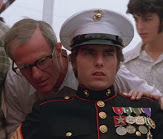
And after the long and rather dull beginning, the movie never lets up and never goes where you expect it to go.
The surprises begin with the build up to the all-important high school wrestling championship which Ron must win.
He loses. And signs up in the marines on the rebound.
 No sooner is he in Vietnam than he is involved in shooting innocent villagers and babies — "Very unfortunate," says his commanding officer.
No sooner is he in Vietnam than he is involved in shooting innocent villagers and babies — "Very unfortunate," says his commanding officer.Moments later he accidentally kills one of his own comrades in arms, Wilson.
When Ron tries to unburden himself about this — "It was very confusing and I think I might have killed him" — his officer snarls, "I don't need anybody to come in here and tell me this shit."
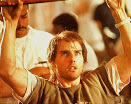
So washing his hands of the whole affair, and leaving Ron struggling to deal with it.
He deals with it by attempting to be a hero, and receiving wounds so severe that the doctors tell him he will never walk again.
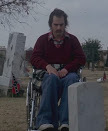 Ron defies them in classic Hollywood fashion by staging, through sheer willpower and physical striving, a rousing recovery.
Ron defies them in classic Hollywood fashion by staging, through sheer willpower and physical striving, a rousing recovery.But, in very un-Hollywood fashion, he takes a grisly fall, shattering his leg and ending up worse off than before.
From here on this is the story of Ron coming to terms with what has happened to him. At first he is content to return to his family and be the war hero in a wheelchair.

But Stone almost immediately undermines these sequences with harsh reality — Ron emptying his catheter before the big parade.
And soon Ron is questioning the simple minded patriotism that took his legs away, and is on his way to become a figurehead of the anti-war movement.
But first he has to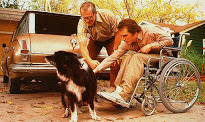 make his peace with Wilson, the American soldier he killed. And he goes to visit Wilson's family and confess what he did.
make his peace with Wilson, the American soldier he killed. And he goes to visit Wilson's family and confess what he did. It's a tough, haunting scene, and probably the highlight of a distinctive and unsual movie that simply doesn't follow any of the predictable story contours.
(Image credits: All from IMDB.)
August 30, 2020
The Removers by Donald Hamilton
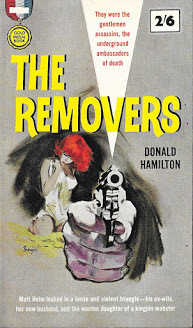 Donald Hamilton is rising swiftly in my estimation. Soaring, in fact.
Donald Hamilton is rising swiftly in my estimation. Soaring, in fact.I have previously written about the first and second novels in his Matt Helm series.
These are nominally spy novels, but essentially they're hardboiled adventure thrillers.
Matt Helm is the American equivalent of James Bond, given license by his government to kill the enemies of the state, receiving orders from the head of a shadowy government department.
But beyond that he is an entirely different creature from Bond. A blue-collar guy who drives a pickup truck, Helm may travel to exotic lo cations like 007 (as he did to Sweden in The Wrecking Crew) but he also emphatically has a home turf and roots in the way that Bond doesn't.
cations like 007 (as he did to Sweden in The Wrecking Crew) but he also emphatically has a home turf and roots in the way that Bond doesn't.
Matt Helm comes from the American Southwest, and when he's writing about that milieu, Hamilton is particularly acute and effective.
Helm also has a domestic background — a wife and kids — in the way that James Bond never did.
 In fact, in my post about the second Helm novel I was bemoaning the fact that Helm's divorce meant this family background was history. I wrote, rather sententiously, "domestic normality to contrast with bloodthirsty action in a thriller provides an interesting dynamic and an ideal counterpoint."
In fact, in my post about the second Helm novel I was bemoaning the fact that Helm's divorce meant this family background was history. I wrote, rather sententiously, "domestic normality to contrast with bloodthirsty action in a thriller provides an interesting dynamic and an ideal counterpoint."
I spoke too soon. Here we are, in the very next book in the series, and the entire plot is triggered by Helm's wife Beth and their kids, who are in jeopardy. A rather sardonic form of jeopardy...
 Because, by a delectable stroke of irony, after dumping and divorcing Matt due to his violent history, it turns out Beth's new husband is just as bad.
Because, by a delectable stroke of irony, after dumping and divorcing Matt due to his violent history, it turns out Beth's new husband is just as bad.Ostensibly a respectable rancher with a large spread outside Reno, Lawrence Logan is revealed to actually be the murderous ex-enforcer for a high ranking Mafia thug.
When his past catches up with him, and therefore her and the kids, Beth turns to Matt Helm for help. 
In my last post I also made a slightly snide comment that "Hamilton isn't quite in the class of John D. MacDonald or Charles Williams."
I fear I'm going to have to eat my words concerning this, too. The writing in The Removers is simply terrific. The only false note is Logan's rather fake British accent. (But then, Logan himself is supposed to be something of a fake.)
And the characters are just wonderful, and enchantingly described.
I am thinking in particular of an Afghan hound called Sheik, looking "rather like a greyhound with shaggy cowboy chaps on. It had a long, narrow inbred head and big pleading brown eyes... standing erect on its hind legs... as tall as the girl on the other end of the leash."
 The girl on the other end of the leash is Moira Fredericks, the daughter of the high ranking Mafia thug mentioned earlier.
The girl on the other end of the leash is Moira Fredericks, the daughter of the high ranking Mafia thug mentioned earlier.
But despite this, or more likely because of it, Moira is one of the good guys.
She has "disturbing sea green eyes" and a mildly tragic backstory in New York where she "was about ready to jump off one of the bridges, it was just a matter of deciding which on e, they've got plenty to choose from in that damn town."
e, they've got plenty to choose from in that damn town."
She was saved by adopting Sheik, "the wildest, meanest, most difficult dog" they had at a kennel she happened to drive past.
Muriel is perceptive, and a great, great character. She certainly has Matt Helm's number, assessing him as "Something kind of special, in a a gruesome sort of way."
Moira and Sheik are the best things in the book. And the scene where Moira and Matt drive out into the Nevada wilderness, letting Sheik off the leash and allowing him to hunt, may well be the most memorable sequence:
"The  transition from the gaudy night life of Reno to the dark, silent desert nearby was almost shocking... an arid landscape that might have been the surface of the moon... vaguely illuminated by the threat of dawn in the east."
transition from the gaudy night life of Reno to the dark, silent desert nearby was almost shocking... an arid landscape that might have been the surface of the moon... vaguely illuminated by the threat of dawn in the east."
When they let him out of the car, Sheik stretches, "his long body flexed like Robin Hood's bow." Soon the dog is running "faster than any deer ever dreamed of." And he's hardly got started...
"Wait till he cuts in the afterburners," says Moira, wryly alluding to a fuel injection system in a jet engine. And the "lean grey dog, running sile ntly, its long fur rippling with the wind of its own motion" is like "pale death flowing over the ground."
ntly, its long fur rippling with the wind of its own motion" is like "pale death flowing over the ground."
Of course, this book isn't about Moira Fredericks and her Afghan hound. They're subsidiary characters.
The real thrust of the story is a neat intertwining of three plot strands — the danger faced by Helm's family, the gangster past of Beth's new husband, and espionage taking place at the nuclear weapons research facilities in the Nevada desert.
It's a story that moves fast and delivers elegant, logical surprises. It's supremel y well told, with vignettes of savagely violent action and heartbreaking tragedy — it actually made me cry at one point, sitting in my garden holding a vintage paperback in one hand and rubbing my loyal cat under the chin with the other.
y well told, with vignettes of savagely violent action and heartbreaking tragedy — it actually made me cry at one point, sitting in my garden holding a vintage paperback in one hand and rubbing my loyal cat under the chin with the other.
And Beth comes out of the shadow of being merely Helm's ex-wife and emerges as something of an extraordinary character in her own right.
But this novel belongs to the sardonic green-eyed Moira, and Sheik, one of the most memorable animals in fiction. When the plot requires the two of them to be side-lined, and moves on to other matters, the book never quite recovers.
Nevertheless, The Removers is easily the best of the Matt Helm adventures I've read so far. It's ironic that such a terrific book has such an anodyne title. (Whereas The Wrecking Crew is a great title applied to an okay book.)
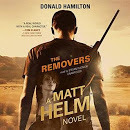
This is an unforgettable novel. And as for Donald Hamilton's stature as a writer, all bets are off.
He may well prove to be up there with the best of them.
(Image credits: The front and back covers of the British Frederick Muller 2/6 version and the US Gold Medal 40c edition are scanned from my own — now treasured — copies. The Titan, Audible and Finnish and Greek editions are from Good Reads. The rest, all Fawcett Gold Medal variants, are from the extremely useful Good Reader Gone Bad.)
August 23, 2020
The Stories of Katherine Mansfield
 Holy crow. You can normally depend on my blog posts to deal with novels about a desperate loner on the run from the police, framed for the murder of a cop...
Holy crow. You can normally depend on my blog posts to deal with novels about a desperate loner on the run from the police, framed for the murder of a cop... Or an army of mutant creatures taken into battle against invading aliens.
Or, at the very least, a movie about a skyscraper on fire.
But this week I'd like to alert you to the short stories of Katherine Mansfield. And there's not a framed fugitive, mutant army or burning skyscraper in sight.
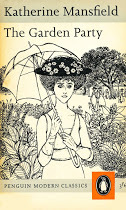 Mansfield was a New Zealander who moved to England as a teenager in 1905 and spent most of her remaining short life there or on the Continent.
Mansfield was a New Zealander who moved to England as a teenager in 1905 and spent most of her remaining short life there or on the Continent. Short indeed. She only lived to be 34, and it was a life so packed with tragedy and misfortune that you may want to skip reading about it.
But it was also packed with writing, and she was the creator of a body of genuinely brilliant and indelible short stories.
 I was aware of Mansfield, but had never read her work. All that changed when I heard some excellent recent dramatisations on BBC Radio, in an impressive two week celebration of her stories.
I was aware of Mansfield, but had never read her work. All that changed when I heard some excellent recent dramatisations on BBC Radio, in an impressive two week celebration of her stories.
These included Miss Brill, a concise and deft account of a spinster whose defensive illusions are destroyed by a chance remark.
And the heart-rending The Doll's House, about the brutality of snobbery and class barriers — between small children.
barriers — between small children.
These, and others equally powerful, got me seeking out a book by Katherine Mansfield and digging deeper into the BBC's archives...
Where I found The Garden Party, another lyrical but ruthless dissection of class distinction and the incredible The Fly.
The Fly is the story of a wealthy businessman whose life has been rendered meaningless by the death of his son in the First World War. He assuages his pain through a tiny — but heartbreaking — act of cruelty.

The Fly and The Garden Party seem to be permanently available for listening online.
As do two anthologies, the first featuring stories including Bliss, an elegant tale of rapture and betrayal.
And the sec ond including Daughters of the Late Colonel, about what happens when you devote your life to a controlling invalid of a parent — and he suddenly drops dead.
ond including Daughters of the Late Colonel, about what happens when you devote your life to a controlling invalid of a parent — and he suddenly drops dead.
On the other hand, Miss Brill and The Doll's House may well no longer be available by the time you read this, but that hardly matters because, l ike me, you can get hold of a book by Katherine Mansfield and read these stories.
ike me, you can get hold of a book by Katherine Mansfield and read these stories.
Mansfield's prose is terse, sharp and funny. Her descriptions are forceful, such as the "dark, oily spinach green" of the eponymous doll's house; and almost dreamlike at times, like the "hot, bright station slipping away" as a train pulls out on a hot summer morning.
And her characters are fabulous, often hilarious and drawn in swift strokes, like Kate, the "proud young" servant of the Colonel's daughters, who sees herself as an "enchanted princess" and the sisters as two "old tabbies".
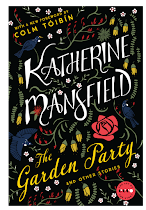 Mansfield's poetic characterisations can cut deep. Like the young husband in Marriage à la Mode who loves his wife so much it literally hurts.
Mansfield's poetic characterisations can cut deep. Like the young husband in Marriage à la Mode who loves his wife so much it literally hurts.He thinks of her as a rose bush "after a shower of rain... petal-soft, sparkling and cool."
Unfortunately for him, his wife is pretentious and vain, running around with a crowd of artistic phonies and spongers.
When he writes her a deeply felt love letter, she reads it to them and they all laugh themselves sick.

Katherine Mansfield was an exceptional talent, cut short by a stroke of fate as cruel and underserved as anything in her stories.
And those stories are well worth seeking out.
(Image credits: The beautiful main illustration, by the great Leo and Diane Dillon, is of the Caedmon LP of reading of Mansfield's stories and is from Discogs.The portrait by Anne Estelle Rice is from Bookanista. The beautiful floral cover for The Garden Party is designed by Holly Dunn, from her own website.
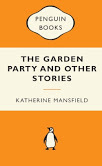
The Oxford Bookworms edition with the seated lady is from Rakuten Kobo. The Oxford Bookworms edition with the standing lady is from Amazon. The lovely and elegant Selected Stories cover is from Mark My Books. The classic orange Penguin if from Literature Cambridge. The floral cover Penguin English Library edition is from Penguin. The Penguin Modern Classic with the black and white cover illustation by Heather Standring is from Pinterest. The lady-in-the-hat Penguin edition with the grey stripe at the bottom is from Books of Gold.)
August 16, 2020
Westworld Season 1 by Crichton, Nolan & Joy
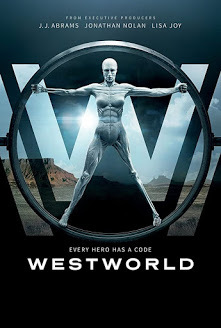 Well, I've finally caught up with the TV series of Westworld. And, spoiler alert, I'm impressed.
Well, I've finally caught up with the TV series of Westworld. And, spoiler alert, I'm impressed.I still have vivid memories of the 1973 Michael Crichton movie it's based on. Not so vivid that I couldn't do with seeing it again, though.
Indeed it's clear that I need to give Michael Crichton a full blown reappraisal. He was an influential, intriguing and diverse talent.
But for now let's talk about the TV series that he inspired, which started in 2016. Crichton was given full credit in the first episode, but from that point on his name was shunted into the small print at the end of the show.
This is what happens to you if you die in Hollywood. It's reprehensible, but what can you do? Especially if you're dead.
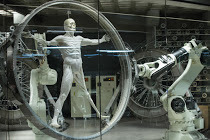
The series was developed for television by Jonathan Nolan, whom I'm sure is utterly sick of being identified as the brother of Christopher Nolan.
Jonathan Nolan is very much a talent in his own right and he is also responsible for Person of Interest, another favourite TV series of mine.

He developed Westworld in collaboration with Lisa Joy, whom I'm sure is utterly sick of being identified as the wife of Jonathan Nolan...
Nolan and Joy have done one hell of a fantastic job. Essentially the original Crichton movie was about a cowboy theme park robot (memorably played by Yul Brynner) rebelling in a lethal fashion. 
(There's a nice little nod to the movie in the TV show when we glimpse the decommissioned Yul Brynner robot in the background in one scene.)
As I recall, in the movie our sympathies were pretty much with the Brynner robot's human victims — the theme park's customers. And the story was essentially from their point of view.

In Westworld the TV series, this is cunningly reversed. We see the situation from the robots' point of view. Which has seismic implications...
The show is full of wit and intelligence. One of the dominant recurring images is a player piano in the saloon in the town of Sweetwater.
Its pre-programmed, inflexible routine, playing music guided by a punched paper tape, is a cogent metaphor for the lives of the robots, repeating their own programmed scenarios, again and again.

Indeed, when you tell this story from the robots' point of view it becomes a very scary version of Groundhog Day.
The horrible plight of the robots — sexually exploited, tortured, murdered, all for the pleasure of the theme park's customers — is powerfully conveyed.
The story alternates between the robots, officially called 'hosts', and the corporate humans who control their destiny.
The humans callously call the hosts 'livestock' and there are rooms full of their discarded, maimed nude bodies.
No longer exactly robots, they have been pushed dangerously in the direction of becoming human, because this makes for better  business — "Your humanity is cost effective."
business — "Your humanity is cost effective."
I was well aware of Westworld, both because of the Crichton source movie and the (well deserved) acclaim it received.
But I had no idea about the calibre of the cast. Thandie (pronounced 'Ta ndy') Newton is Maeve, the madam of the saloon bordello in Sweetwater.
ndy') Newton is Maeve, the madam of the saloon bordello in Sweetwater.
And none other than Anthony Hopkins is the creator of her and her fellow robots, Ford — a rather on-the-nose name, don't you think, for the pioneer of a new consumer technology?
 While most of the robots go unquestioningly about their hellish lives, Maeve has begun to question what is going on. When her character gets killed, and taken in for repair, she wakes up in the lab and glimpses reality.
While most of the robots go unquestioningly about their hellish lives, Maeve has begun to question what is going on. When her character gets killed, and taken in for repair, she wakes up in the lab and glimpses reality.
So she begins to arrange her own death, to get more of these glimpses of the real world — rather like the use of the 'suicide express' in Philip José Farmer's Riverworld novels.

Maeve is great, and Ford is pretty intriguing, too. But for me one of the most engaging characters is the monstrous Lee Sizemore (Simon Quarterman), the heartless nerd in charge of 'narrative' for Westworld.
In other words, he creates the horrible fates for these poor robots.
There's plenty more to say about Westworld. And as I finish this first season and move on to its sequels, I hope to discuss it in some detail.
(Image credits: IMDB.)
August 9, 2020
Low Action by Andrew Cartmel
 My fifth Vinyl Detective novel has just been published and I hope you'll permit me the indulgence of discussing — and of course promoting — it here.
My fifth Vinyl Detective novel has just been published and I hope you'll permit me the indulgence of discussing — and of course promoting — it here.
I'd like to reassure any prospective readers, however, that I won't be giving away any spoilers. You can read this post before you read the book, and no damage will be done...
Each of the Vinyl Detective stories tends to focus on a different genre of music, and for this excursion, Low Action, it's punk rock.
 The novels in the series often also involve a search for a rare recording — which in some cases mean one that was suppressed.
The novels in the series often also involve a search for a rare recording — which in some cases mean one that was suppressed.
It was my friend the composer Joe Kraemer who came up with the sardonic suggestion that the rare record in this book had been pulled from the shelves because the playing on it was too good for a punk LP.
 I loved that, added it to the plot, and duly set about my research and preparation for the story. The first step was to come up with a suitable name for the imaginary (all girl) punk band in the book.
I loved that, added it to the plot, and duly set about my research and preparation for the story. The first step was to come up with a suitable name for the imaginary (all girl) punk band in the book.
Here's a selection of names that didn't make the cut: The Chuff, The Bints, The Scrubbers, The Kippers, The Duff, The Birds, The Muff, Bimbo Eruption, Bad Kissing, Unauthorised Nudity, Rough Garden and Lovely Furry Killing Machines — LFKM, a name that signified cats!
The latter, inspired by a tweet from @LogBookGuy was far and away my favourite — thank you, @LogBookGuy! And I may well use it one day. But for plot reasons I settled on something else for the protagonists of this novel.
inspired by a tweet from @LogBookGuy was far and away my favourite — thank you, @LogBookGuy! And I may well use it one day. But for plot reasons I settled on something else for the protagonists of this novel.
Another friend, the novelist Ben Aaronovitch, requested that one of the characters from his own novels make an appearance in my book, since he wanted to establish a backstory for that character as a punk. I was happy to oblige.
My research on the punk rock era proved invaluable. Not least because I discovered the importance of fanzines to the scene — and that gave me a character I hadn't had before, one who wrote and published (althou gh publish is far too grand a word) an amateur magazine about the band in the book.
gh publish is far too grand a word) an amateur magazine about the band in the book.
The other big influence on this novel was, oddly enough, Agatha Christie. The Vinyl Detective stories sometimes reflect my admiration for other crime writers.
I've mentioned  before how in the third book in the series, Victory Disc, I wanted to try my hand at the sort of unbearable, claustrophobic suspense that Cornell Woolrich was such a master of.
before how in the third book in the series, Victory Disc, I wanted to try my hand at the sort of unbearable, claustrophobic suspense that Cornell Woolrich was such a master of.
This time, as I say, it was Agatha Christie. In particular the brilliant way she would set up a whole panel of suspects for the role of murderer — all of whom were equally plausible as being innocent or guilty.
I hope I've had a fraction of the great Christie's success in pulling the wool over the eyes of the readers.
And I hope you'll check the book out (literally check it out, of a library, if you like) and that you will enjoy it.
Oh, and as a special bonus and Easter egg, here is a little portion of the book that was cut from the final version:
"...make it look like an accident…”

“Make it look like an accident?” said Nevada. There was the deadly serious promise of mayhem in in her voice and my eyes immediately went to the large and bulbous glass sugar shaker on the table in front of us, because it looked like Monika was about half a second away from getting this smashed into her face.
(Image credits: All are from my own collection, the Vinyl Detective covers from Titan Books and the copy of Peril at End House with the beautiful Tom Adams cover and the vintage Pocket Book of The Bride Wore Black with the equally lovely H. Lawrence Hoffman art are both scanned from the ones in my library.)
August 2, 2020
The Wrecking Crew by Donald Hamilton
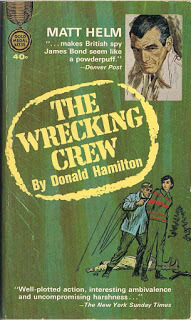 It's a terrific feeling to wake up in the morning and know there's a book you're in the middle of reading and looking forward to picking up again.
It's a terrific feeling to wake up in the morning and know there's a book you're in the middle of reading and looking forward to picking up again.Last week I wrote about Donald Hamilton's Death of a Citizen, his first Matt Helm adventure. Thanks to the speedy response of a secondhand book seller – and, credit where it's due, to the readability of Hamilton's story — I am now in a position to discuss the next book in the series.
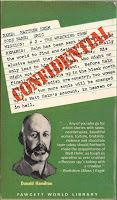 In that first book Matt Helm, a former assassin for his government in a time of war, was settled, staid and respectable; a married man with three children. I didn't expect that to last.
In that first book Matt Helm, a former assassin for his government in a time of war, was settled, staid and respectable; a married man with three children. I didn't expect that to last. In some ways it was too good to last — personally, I think having domestic normality to contrast with bloodthirsty action in a thriller provides an interesting dynamic and an ideal counterpoint.
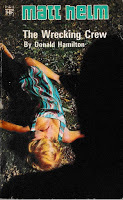 But in the period that Hamilton wrote these books (the early 1960s) action heroes were invariably loners. The model of the secret agent who also has a home life wouldn't really surface until the James Cameron movie True Lies in 1994.
But in the period that Hamilton wrote these books (the early 1960s) action heroes were invariably loners. The model of the secret agent who also has a home life wouldn't really surface until the James Cameron movie True Lies in 1994.So I fully expected Matt Helm to be divested of his family by the end of the first book. Indeed, I half expected and was braced for them to be massacred by evil commie bad guys to send our hero on a revenge spree that would last for dozens of novels.
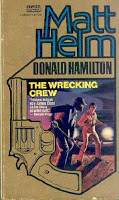 Fortunately, that didn't happen — bad things ensued, but none that bad. What Donald Hamilton came up with was much more interesting. Matt Helm's wife Beth had no idea of her husband's secret past...
Fortunately, that didn't happen — bad things ensued, but none that bad. What Donald Hamilton came up with was much more interesting. Matt Helm's wife Beth had no idea of her husband's secret past...And when she finds out, she just can't handle it. So she leaves him, taking their kids with her. Leading to Helm's bitter reflection, "she'd never have dreamed of breaking up our home if she'd merely discovered, say, that I was the bombardier who'd pushed the button over Hiroshima."
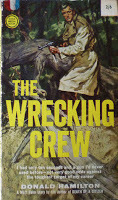 Indeed, this being the height of the Cold War, the thought of death by nuclear weapons is never far away. Leading Helm to consider how the sound of a siren could signify "a brush fire in a vacant lot... or an intercontinental missile with a hydrogen warhead zeroed in on your home town."
Indeed, this being the height of the Cold War, the thought of death by nuclear weapons is never far away. Leading Helm to consider how the sound of a siren could signify "a brush fire in a vacant lot... or an intercontinental missile with a hydrogen warhead zeroed in on your home town."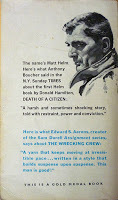 Helm is a long way from his own New Mexico home town in The Wrecking Crew (the title refers to the shadowy government agency for whom he works). He's travelled to Sweden to put the "touch" on — i.e. kill — a Soviet agent. The plot of this novel doesn't feature any breathtaking twist to rival that of the first book.
Helm is a long way from his own New Mexico home town in The Wrecking Crew (the title refers to the shadowy government agency for whom he works). He's travelled to Sweden to put the "touch" on — i.e. kill — a Soviet agent. The plot of this novel doesn't feature any breathtaking twist to rival that of the first book.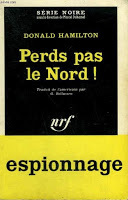 But there are other pleasures. Hamilton has the good sense to make his stories slowly cumulative, carrying just enough over from previous adventures to enrich the mix and give his hero some depth and reality. Hence those jaundiced reflections about his ex-wife.
But there are other pleasures. Hamilton has the good sense to make his stories slowly cumulative, carrying just enough over from previous adventures to enrich the mix and give his hero some depth and reality. Hence those jaundiced reflections about his ex-wife.And whereas the femme fatale in the first book was sort of unconvincingly and synthetically foreign, here we have a cast of more much authentic Swedes. Perhaps because, like his hero, Hamilton has Swedish ancestry, he's taken his research seriously.
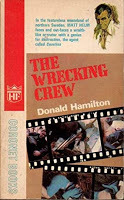 Helm's cover story is that he's a photographer for a magazine (in the first book he was both a writer and a photographer) and clearly Donald Hamilton knows this craft. He has some fascinating things to say, as asides, about the difference between black and white and colour film in low light conditions.
Helm's cover story is that he's a photographer for a magazine (in the first book he was both a writer and a photographer) and clearly Donald Hamilton knows this craft. He has some fascinating things to say, as asides, about the difference between black and white and colour film in low light conditions.And there's the great observation, as Helm deliberately destroys a roll of film by exposing it to daylight, that "There's nothing as permanent and irrevocable as fogging a film, except killing a man."
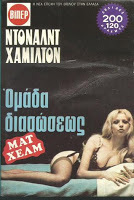 And, sure enough, men — and women — get killed in the course of this taut, compact suspense novel. But you won't guess which ones.
And, sure enough, men — and women — get killed in the course of this taut, compact suspense novel. But you won't guess which ones.Donald Hamilton isn't quite in the class of John D. MacDonald or Charles Williams, but he is very, very good. His plots are precision engineered and often ingenious, and he writes well: "We... were driven in to town, leaving the plane standing alone in the arctic wasteland with only the cold wind for company."
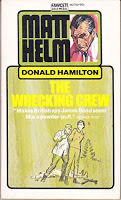 And there are moments of cool, offhand profundity in his characterisation, like the woman who says her husband "couldn't always be bothered with being kind."
And there are moments of cool, offhand profundity in his characterisation, like the woman who says her husband "couldn't always be bothered with being kind."Hamilton's female characters are particularly memorable, and often informed with the sardonic humour which is one of his most appealing features.
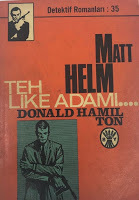 Take Lou Taylor, for instance, the woman with the above-mentioned husband: "she wasn't exactly from Sexville, as the cats back home would put it," but she is nevertheless appealing with her "taut, shorn, dark leanness."
Take Lou Taylor, for instance, the woman with the above-mentioned husband: "she wasn't exactly from Sexville, as the cats back home would put it," but she is nevertheless appealing with her "taut, shorn, dark leanness."Or there's Elin von Hoffmann who is "something to make you weep for your wasted life."
Matt Helm himself is a "bright, ruthless guy" with a "diabolical soul" who'd "once survived a war mainly by putting no faith whatever in the power of coincidence."
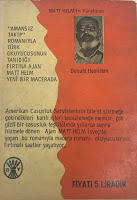 Cynical, fast moving, satisfyingly evocative and occasionally very thrilling indeed, The Wrecking Crew is a strong sequel to Death of a Citizen.
Cynical, fast moving, satisfyingly evocative and occasionally very thrilling indeed, The Wrecking Crew is a strong sequel to Death of a Citizen.But I'm already moving ahead — and looking forward to — book three in the series.
(Image credits: My starting point, as usual, was Good Reads. The British Gold Medal back cover is from Existential Ennui. The Gold Medal 40c front and back cover is from eBay seller kenz430, the 95c is a stock image from ABE. The Fawcett $1.50 is also a stock image from ABE. The Coronet edition with the film strips is also from ABE, although that particular copy is apparently no longer listed. The later Coronet edition with the green Matt Helm logo at the top is from GD Price on ABE. The Serie Noir French translation is from Les Livre on ABE. The front and back cover of the Turkish edition is from Collectybles on eBay.)
July 26, 2020
Death of a Citizen by Donald Hamilton
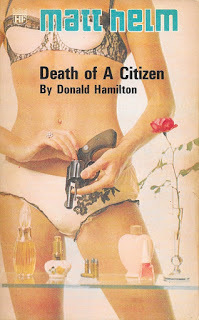 Matt Helm was the American answer to James Bond — a spy empowered to kill enemies of the state. But if he's remembered now, it's all too likely to be in connection with the brief series of films that were made of the books.
Matt Helm was the American answer to James Bond — a spy empowered to kill enemies of the state. But if he's remembered now, it's all too likely to be in connection with the brief series of films that were made of the books.These, too, were the American answer to Bond — they sought to top the more extravagant and fantastical elements of the 007 franchise and they were terribly camp. My memories of them are of flying saucers and go-go dancers and Dean Martin looking none too convincing holding a submachine gun.
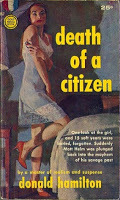 (There's a clip from one of these Matt Helm movies in Quentin Tarantino's Once Upon a Time in Hollywood.)
(There's a clip from one of these Matt Helm movies in Quentin Tarantino's Once Upon a Time in Hollywood.) But it's unjust to judge books by the films they spawned. The Matt Helm novels were the creations of Donald Hamilton, a writer who was similar to Elmore Leonard in that, while he would become a major figure in suspense fiction, he spent the better part of the 1950s writing Westerns.
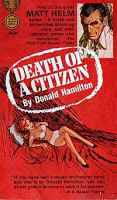 Indeed, his hero Matt Helm is also a writer of Westerns, living with his wife and kids in Santa Fe, New Mexico (a good place for a creator of Westerns to reside). He is peacefully settled into a routine and mundane existence.
Indeed, his hero Matt Helm is also a writer of Westerns, living with his wife and kids in Santa Fe, New Mexico (a good place for a creator of Westerns to reside). He is peacefully settled into a routine and mundane existence.But during the Second World War, Helm had been a secret agent — in fact an assassin. And when we first meet him, in the opening pages of Death of a Citizen, he is at a cocktail party where he recognises a beautiful woman called Tina, who had fought at his side — "our world had been young and savage and alive, instead of being old and civilised and dead."
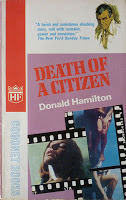
Tina gives him a wordless signal that she's still active and not to blow her cover, leaving Helm's head spinning with memories of the two of them "making love... in a ditch in the rain, while uniformed men beat the dripping bushes all around us."
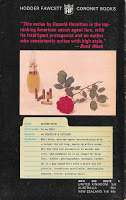
To her credit, Helm's wife Beth immediately senses that something is up. But there's no way that she can stop what's coming. Before you know it, Helm is compelled to help Tina dispose of a corpse — an enemy operative — and they are on the run together across a memorably described southwestern wilderness.
Tina is sort of generically foreign and exotic — Hamilton can't seem to make up his mind if she's French or German, or what the hell she is.
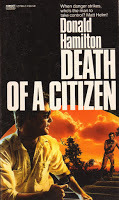
But she, too, is memorably described, both in retrospect as a "bedraggled fury" killing a German officer in the "wet woods at Kronheim" during the war, and in the present "stretching and yawning like a waking cat" on the first morning of their new adventure together.
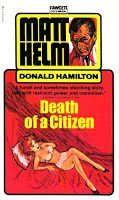 But Matt Helm has no illusions about Tina. "She wasn't a person in whom one could place one's childlike and innocent trust."
But Matt Helm has no illusions about Tina. "She wasn't a person in whom one could place one's childlike and innocent trust."He tells Tina, "I'm bound to be unfaithful to my wife before I'm through with you... Let's get it over with so I can stop wrestling with my conscience."
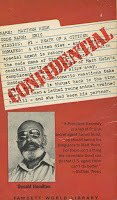 Tina says, "I do not think you are wrestling very hard." Helm shrugs and replies, "It's not much of a conscience."
Tina says, "I do not think you are wrestling very hard." Helm shrugs and replies, "It's not much of a conscience."Besides showing Donald Hamilton's gift for sardonic wit, the fact that Helm so casually betrays his wife is a bracing, cynical shock, and oddly elevates the book to a more mature and serious level.
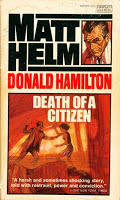 What ensues is a well paced and entertaining thriller populated with vivid and often amusingly evoked characters, and possessed of a really terrific plot twist.
What ensues is a well paced and entertaining thriller populated with vivid and often amusingly evoked characters, and possessed of a really terrific plot twist.It also features some things I found quite hard to take, which is fair enough. In a book so full of violent action and killing there should at least be a sense of consequence and loss...
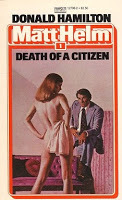 And incidentally the "death" of the citizen in the title refers to the fact that Matt Helm can never return to the routine normality of his old life after undergoing the events in this story.
And incidentally the "death" of the citizen in the title refers to the fact that Matt Helm can never return to the routine normality of his old life after undergoing the events in this story.To give you some idea of how impressed I was with novel, I am going straight online to look for the next book in the series.
(I just discovered that Titan Books have laudably reprinted the entire Matt Helm series. I tend to hold Titan in high regard — they also publish my Vinyl Detective novels.)
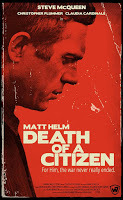 (Image credits: The Hodder Fawcett/Coronet copy with the lingerie clad model loading the gun on the front cover — so objectified that her head has been removed — and the back cover with its rose and perfume bottle, are scanned from the copy I read. The others are mostly from Good Reads. With these exceptions... The earlier Coronet with the film frames on the cover is from Existential Ennui. The red Fawcett back cover is from Flickr. The entirely imaginary but very nicely done movie tie-in with Steve McQueen posited in the role of Matt Helm is from an excellent post at Hazard Publishing and is © 2014 N. David Bauer. The Fawcett white $2.50 cover is from Grave Tapping. The Fawcett black $3.50 cover is from the Nick Carter and Carter Brown blog.)
(Image credits: The Hodder Fawcett/Coronet copy with the lingerie clad model loading the gun on the front cover — so objectified that her head has been removed — and the back cover with its rose and perfume bottle, are scanned from the copy I read. The others are mostly from Good Reads. With these exceptions... The earlier Coronet with the film frames on the cover is from Existential Ennui. The red Fawcett back cover is from Flickr. The entirely imaginary but very nicely done movie tie-in with Steve McQueen posited in the role of Matt Helm is from an excellent post at Hazard Publishing and is © 2014 N. David Bauer. The Fawcett white $2.50 cover is from Grave Tapping. The Fawcett black $3.50 cover is from the Nick Carter and Carter Brown blog.)
July 19, 2020
The Towering Inferno by Stirling Silliphant
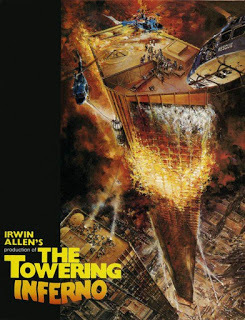 I know, I know... posting about a Western, and now a disaster movie.
I know, I know... posting about a Western, and now a disaster movie. Well, if you steered clear of The Towering Inferno all your life because it looks like a cheesy piece of mainstream Hollywood junk, then you're in good company.
Or, at least you're in my company, because I've been avoiding this movie since 1974 for exactly that reason. What changed my mind?
Well, the fact that it was written by Stirling Silliphant.

Silliphant (odd name, I know) was a dismayingly prolific screenwriter, which makes it easy to assume he's just no good. In fact he's a distinctive and intriguing talent.
He worked extensively in television on the ground breaking shows Naked City and Route 66, then moved to Hollywood where he won an Oscar for his script for In the Heat of the Night. But let's come back to Stirling Silliphant in a moment.
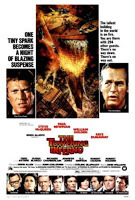
The Towering Inferno came about when two major movie studios discovered that they had each bought similar novels about a massive fire ravaging a glass skyscraper...
The novels were The Tower by Richard Martin Stern and The Glass Inferno by Thomas Scortia and Frank Robinson. 20th Century Fox bought The Glass Inferno and Warner Bros. bought The Tower.
 They had each spent a lot of money to acquire these books and were going to spend vastly more on making two virtually identical movies. This potentially bankrupting collision was avoided by one of the rare outbreaks of common sense in Hollywood history.
They had each spent a lot of money to acquire these books and were going to spend vastly more on making two virtually identical movies. This potentially bankrupting collision was avoided by one of the rare outbreaks of common sense in Hollywood history.Fox and Warner decided to pool their resources and collaborate on making a single blockbuster film. So The Tower and The Glass Inferno were combined to form The Towering Inferno.
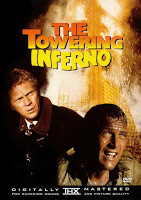 The picture was directed by John Guillermin, a Brit with an interesting track record (The Blue Max, Shaft in Africa) and produced by Irwin Allen, famed in his day for spectacles, schlock and science fiction (coincidentally, Scortia and Robinson who wrote The Glass Inferno also had backgrounds in science fiction).
The picture was directed by John Guillermin, a Brit with an interesting track record (The Blue Max, Shaft in Africa) and produced by Irwin Allen, famed in his day for spectacles, schlock and science fiction (coincidentally, Scortia and Robinson who wrote The Glass Inferno also had backgrounds in science fiction).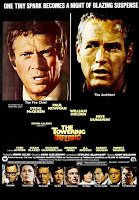 Irwin Allen, whose career would be all downhill from The Towering Inferno, also takes a credit on the film for directing the action sequences.
Irwin Allen, whose career would be all downhill from The Towering Inferno, also takes a credit on the film for directing the action sequences.The directing of the movie as a whole ranges from effective to incompetent. And in those action sequences which Allen was so eager to lay claim to, it's sometimes difficult to even know what is happening, at least in the DVD print that I watched.
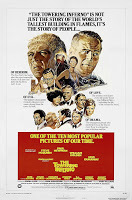 The screenplay, however, is a different matter. It is ferociously proficient. Recalling his work on the movie in an interview Stirling Silliphant said, "You have to deal with the logistics of the physical action... what you are not doing is writing. What you are doing is juggling."
The screenplay, however, is a different matter. It is ferociously proficient. Recalling his work on the movie in an interview Stirling Silliphant said, "You have to deal with the logistics of the physical action... what you are not doing is writing. What you are doing is juggling."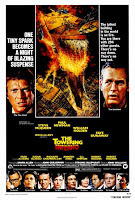 That is, juggling the large cast of characters. Interestingly, when he was planning the screenplay Silliphant even treated the fire as a character — "my favourite character in the script" — and gave it a name.
That is, juggling the large cast of characters. Interestingly, when he was planning the screenplay Silliphant even treated the fire as a character — "my favourite character in the script" — and gave it a name.And the end result, despite the cheesy trappings of the movie, is gripping and unpredictable — you won't be able to guess who lives and who dies.
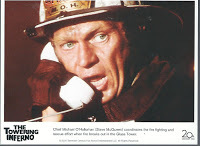 But Silliphant's writing was not just a masterful exercise in logistics, he also crafted some superb dialogue. The fire chief O'Halloran, played by Steve McQueen, talks about what death traps these skyscrapers are and how he's sick of "eating smoke and pulling out bodies."
But Silliphant's writing was not just a masterful exercise in logistics, he also crafted some superb dialogue. The fire chief O'Halloran, played by Steve McQueen, talks about what death traps these skyscrapers are and how he's sick of "eating smoke and pulling out bodies." 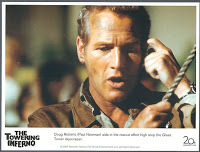 Silliphant reminisced amusingly about dealing with the egos of his two leading men, McQueen and Paul Newman. (Look at the publicity material for the film, which has been cunningly designed so that they both appear to be getting top billing.) But he concludes,
Silliphant reminisced amusingly about dealing with the egos of his two leading men, McQueen and Paul Newman. (Look at the publicity material for the film, which has been cunningly designed so that they both appear to be getting top billing.) But he concludes,"Despite this, The Towering Inferno did emerge as a powerful and engrossing film."

And he's right. But regarding the competition between McQueen and Newman, there is really no contest. Steve McQueen is easily the best thing in the movie, impressive — low key and believable and tremendously watchable.
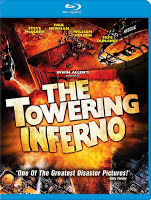 Admittedly his role as the fire chief was a hell of a lot more interesting that Newman's part as the architect... but it is Steve McQueen's naturalistic, understated, contained acting style which really triumphs, making Paul Newman look outmoded and cumbersome by comparison.
Admittedly his role as the fire chief was a hell of a lot more interesting that Newman's part as the architect... but it is Steve McQueen's naturalistic, understated, contained acting style which really triumphs, making Paul Newman look outmoded and cumbersome by comparison.I watched this film expecting it to launch me on a mini-festival of movies written by Stirling Silliphant. In fact, it looks more likely to set me off on a retrospective of pictures starring Steve McQueen, a great actor and a major movie star in his day, now mostly forgotten...
 At the conclusion of The Towering Inferno there is great satisfaction in seeing the fire finally snuffed out.
At the conclusion of The Towering Inferno there is great satisfaction in seeing the fire finally snuffed out. But, for me, the big emotional moment was discovering that Jennifer Jones's cat had been safely rescued — even though the rescuer was an actor called O.J. Simpson...
(Image credits: All from IMDB.)



